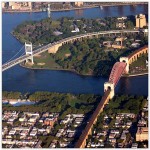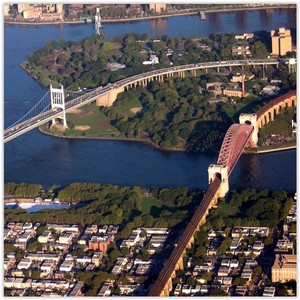 Astoria is a middle-class and commercial neighborhood with a population of 154,000 in the northwestern corner of the New York City borough of Queens. Located in Community Board 1, Astoria is bounded by the East River and is adjacent to three other Queens neighborhoods: Long Island City, Sunnyside (bordering at Northern Boulevard), and Woodside (bordering at 50th Street). Astoria is patrolled by the New York City Police Department’s 114th Precinct.
Astoria is a middle-class and commercial neighborhood with a population of 154,000 in the northwestern corner of the New York City borough of Queens. Located in Community Board 1, Astoria is bounded by the East River and is adjacent to three other Queens neighborhoods: Long Island City, Sunnyside (bordering at Northern Boulevard), and Woodside (bordering at 50th Street). Astoria is patrolled by the New York City Police Department’s 114th Precinct.
HISTORY
The area now known as Astoria was originally called Hallet’s Cove, after its first landowner William Hallet, who settled there in 1659 with his wife, Elizabeth Fones. Beginning in the early 19th century, affluent New Yorkers constructed large residences around 12th and 14th streets, an area that later became known as Astoria Village (now Old Astoria). Hallet’s Cove, founded in 1839 by fur merchant Stephen A. Halsey, was a noted recreational destination and resort for Manhattan’s wealthy.
The area was renamed after John Jacob Astor, then the wealthiest man in America with a net worth of over $40 million, in order to persuade him to invest just $2,000 in the neighborhood. He only invested $500, but the name stayed nonetheless, as a bitter battle over naming the village finally was won by Astor’s supporters and friends. From Astor’s summer home in Hell Gate, Manhattan – on what is now East 87th Street near York Avenue – he could see across the East River the new Long Island village named in his honor. Astor, however, never actually set foot in Astoria.
During the second half of the 19th century, economic and commercial growth brought increased immigration from German settlers, mostly furniture and cabinet makers. One such settler was Heinrich Engelhard Steinweg, patriarch of the Steinway family who founded the piano company Steinway & Sons in 1853, which today is a worldwide piano company. Later on the Steinways built a sawmill and foundry, as well as a streetcar line. The family eventually established Steinway Village for their workers, a company town that provided school instruction in German as well as English.
Astoria and several other surrounding villages, including Steinway, were incorporated into Long Island City in 1870. Long Island City remained an independent municipality until it was incorporated into New York City in 1898. The area’s farms were turned into housing tracts and street grids to accommodate the growing number of residents.
Astoria also figured prominently in early American filmmaking as one of its initial centers, a heritage preserved today by the Museum of the Moving Image and Kaufman Astoria Studios.
Today, much of the Astoria waterfront is being redeveloped and underutilized industrial sites in forgotten historic neighborhoods are being revived. Hallets Point is one of five former industrial sites on the waterfront being transformed, and will bring seven new mixed-use residential towers, including 2,000 market-rate units and 500 affordable units, into the neighborhood. The development will also include new waterfront parks, a supermarket, retail shops and restaurants, and two new schools. These waterfront projects were designed by a New York architectural firm, in conjunction with private developers, city agencies and landscape architects.
DEMOGRAPHICS
Astoria was first settled by the Dutch and Germans in the 17th century; many Irish settled in the area during the waves of Irish immigration into New York City during the 19th and early 20th centuries. Italians were the next significant immigrants in Astoria, and numerous Italian restaurants, delis, bakeries, and pizza shops are found throughout Astoria, particularly in the Ditmars Boulevard area.
Jews were also a significant ethnic and religious group. The Astoria Center of Israel, which is listed on the National Register of Historic Places, was built in 1925 after outgrowing the former Congregation Mishkan Israel, which was built in 1904.
The 1960s saw a large number of ethnic Greeks from Greece, and immigrants from Cyprus in 1974. The Greek cultural imprint can be seen in the numerous Greek restaurants, bakeries, tavernas and cafes, as well as several Greek Orthodox churches. While the population of Greeks in Astoria was 22,579 in 1980, it dropped to 18,127 by 1990 due to decreased immigration and lower birth rates. Greek organizations in the area include the Hellenic American Action Committee (HANAC) and the Federation of Hellenic Societies of Greater New York.
Beginning in the mid-1970s, the neighborhood’s Arab population grew from earlier immigrants from Lebanon to also include people from Egypt, Syria, Yemen, Tunisia, Morocco and Algeria. In the 1990s, Steinway Street between 28th Avenue and Astoria Boulevard saw the establishment of many Arabic shops, restaurants and cafes, which is unofficially called “Little Egypt”. Many Maltese live in Astoria, around 20,000, and although this population has steadily been emigrating from the area, there are still many Maltese, supported by the Maltese Center of New York.
Astoria’s South American and European population has seen significant growth since the early 1990s, including a large population of Brazilians, who reside in the 36th Avenue area. Albanians, Bulgarians, and Bosnians have also shown a rise in numbers. Many Spanish Americans live in Astoria, with most of them being of Galician heritage from Northwestern Spain; this community being supported by the Casa Galicia, or Galicia House.
At a period many Bangladeshi Americans settled in Astoria, Queens, but by 2001 many of the Bangladeshi American people who had settled in Astoria moved to Metro Detroit. A survey of an Astoria-area Bengali language newspaper estimated that, in an 18-month period until March 2001, 8,000 Bangladeshi people moved to the Detroit area. However, as of 2010, the Bangladeshi American community in Astoria has been increasing, as Bangladeshi immigrants are increasingly settling in Astoria.
Population losses in Queens were particularly high in immigrant neighborhoods such as Astoria, which suffered the greatest population loss in the city—it lost over 10,000 residents between the years 2000 and 2010.

